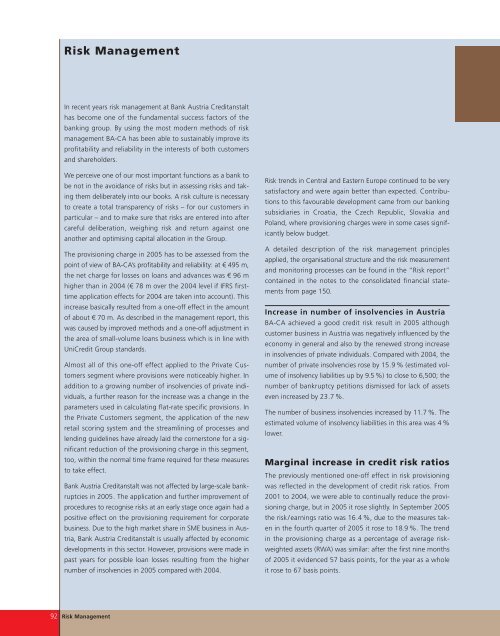team spirit - Bankier.pl
team spirit - Bankier.pl
team spirit - Bankier.pl
You also want an ePaper? Increase the reach of your titles
YUMPU automatically turns print PDFs into web optimized ePapers that Google loves.
Risk Management<br />
In recent years risk management at Bank Austria Creditanstalt<br />
has become one of the fundamental success factors of the<br />
banking group. By using the most modern methods of risk<br />
management BA-CA has been able to sustainably improve its<br />
profitability and reliability in the interests of both customers<br />
and shareholders.<br />
We perceive one of our most important functions as a bank to<br />
be not in the avoidance of risks but in assessing risks and taking<br />
them deliberately into our books. A risk culture is necessary<br />
to create a total transparency of risks – for our customers in<br />
particular – and to make sure that risks are entered into after<br />
careful deliberation, weighing risk and return against one<br />
another and optimising capital allocation in the Group.<br />
The provisioning charge in 2005 has to be assessed from the<br />
point of view of BA-CA’s profitability and reliability: at € 495 m,<br />
the net charge for losses on loans and advances was € 96 m<br />
higher than in 2004 (€ 78 m over the 2004 level if IFRS firsttime<br />
ap<strong>pl</strong>ication effects for 2004 are taken into account). This<br />
increase basically resulted from a one-off effect in the amount<br />
of about € 70 m. As described in the management report, this<br />
was caused by improved methods and a one-off adjustment in<br />
the area of small-volume loans business which is in line with<br />
UniCredit Group standards.<br />
Almost all of this one-off effect ap<strong>pl</strong>ied to the Private Customers<br />
segment where provisions were noticeably higher. In<br />
addition to a growing number of insolvencies of private individuals,<br />
a further reason for the increase was a change in the<br />
parameters used in calculating flat-rate specific provisions. In<br />
the Private Customers segment, the ap<strong>pl</strong>ication of the new<br />
retail scoring system and the streamlining of processes and<br />
lending guidelines have already laid the cornerstone for a significant<br />
reduction of the provisioning charge in this segment,<br />
too, within the normal time frame required for these measures<br />
to take effect.<br />
Bank Austria Creditanstalt was not affected by large-scale bankruptcies<br />
in 2005. The ap<strong>pl</strong>ication and further improvement of<br />
procedures to recognise risks at an early stage once again had a<br />
positive effect on the provisioning requirement for corporate<br />
business. Due to the high market share in SME business in Austria,<br />
Bank Austria Creditanstalt is usually affected by economic<br />
developments in this sector. However, provisions were made in<br />
past years for possible loan losses resulting from the higher<br />
number of insolvencies in 2005 compared with 2004.<br />
92 Risk Management<br />
Risk trends in Central and Eastern Europe continued to be very<br />
satisfactory and were again better than expected. Contributions<br />
to this favourable development came from our banking<br />
subsidiaries in Croatia, the Czech Republic, Slovakia and<br />
Poland, where provisioning charges were in some cases significantly<br />
below budget.<br />
A detailed description of the risk management princi<strong>pl</strong>es<br />
ap<strong>pl</strong>ied, the organisational structure and the risk measurement<br />
and monitoring processes can be found in the “Risk report”<br />
contained in the notes to the consolidated financial statements<br />
from page 150.<br />
Increase in number of insolvencies in Austria<br />
BA-CA achieved a good credit risk result in 2005 although<br />
customer business in Austria was negatively influenced by the<br />
economy in general and also by the renewed strong increase<br />
in insolvencies of private individuals. Compared with 2004, the<br />
number of private insolvencies rose by 15.9 % (estimated volume<br />
of insolvency liabilities up by 9.5 %) to close to 6,500; the<br />
number of bankruptcy petitions dismissed for lack of assets<br />
even increased by 23.7 %.<br />
The number of business insolvencies increased by 11.7 %. The<br />
estimated volume of insolvency liabilities in this area was 4 %<br />
lower.<br />
Marginal increase in credit risk ratios<br />
The previously mentioned one-off effect in risk provisioning<br />
was reflected in the development of credit risk ratios. From<br />
2001 to 2004, we were able to continually reduce the provisioning<br />
charge, but in 2005 it rose slightly. In September 2005<br />
the risk/earnings ratio was 16.4 %, due to the measures taken<br />
in the fourth quarter of 2005 it rose to 18.9 %. The trend<br />
in the provisioning charge as a percentage of average riskweighted<br />
assets (RWA) was similar: after the first nine months<br />
of 2005 it evidenced 57 basis points, for the year as a whole<br />
it rose to 67 basis points.
















